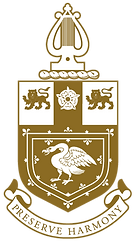On the 25th October 1904, the Court was informed that Colonel J.B. Shaw-Hellier had presented a 'large banner' to the Company. The 1st Handbook reports that it was after the painting in the Musée du Louvre by Domenico Zampieri dit le Dominiquin (1581-1641) and was produced by the method known as 'Tapestry Painting'. This is the process by which linen is painted by an artist such that it looks like tapestry work, but is not a tapestry nor an embroidery. The Shaw-Hellier banner (shown left) was carried on an ebonised pole, the Lyre at the top of which was in polished brass.
To the right is shown the Ash Banner. It was presented to the Musicians' Company in November 1908 by Mr William H. Ash, JP, on his election to the Presidency of the Livery Club. It is said to have been "...done in needlework in the Old English style, the hands and face of the figure alone being painted" (1st Company Handbook, 3rd edition, 1915). It was first used at the Annual St Cecilia Commemoration at St Paul's Cathedral on 23rd November being presented at the front of the procession. The Shaw-Hellier Banner was also used in this procession.
In a Programme produced for a Musicians' Company event at Stationers' Hall on 22nd November 1909 (see two images left), a picture of the Banner was shown with the following inscription:
"This banner, a description of which appeared in "The Queen" of July 13 1895, is an admirable piece of workmanship, and it was awarded a medal and diploma at the Chicago Exhibition. It was designed by Mr Oswald Fleuss, who also painted the lovely face and hands of the saint. The embroidery was carried out by Miss Digby, a clever colourist, who has secured a rich and glowing effect pleasantly subdued by softer tones."
Mary Digby died in 1924 and reference to this piece of embroidery is made in an epitaph on her tomb in Gloucestershire as follows:
In London on Cecilia's Day
If in St Paul's your eye should stray
And on Cecilia's banner fall
T'was Mary Digby made it all.
In October 1936 the Clerk informed the Court that the banners currently in its posession (the Shaw-Hellier and the Ash) were both in need of significant repair and he was ordered to investigate costs. However, at the next Court meeting in January 1937 a new Banner was offered to the Company by Sir Ian Malcolm. This was accepted "...with acclamation" and no further discussion on repairing the older banners was recorded in the Minutes. The Malcolm Banner was described in 1952 as "...the Company's Arms embroidered on a blue silk ground". No image of this banner has so far been located.
Sadly, all three banners were destroyed beyond repair as a result of enemy action in 1940. They were being stored in the loft of Stationers' Hall when that building was set ablaze.
At a Court meeting on 8th January 1952, the Senior Warden (and Treasurer), Mr W. Graham Wallace offered to part-fund the replacement of the Malcolm Banner with a copy, to be produced by the Royal School of Needlework. This was accepted by the Court with gratitude. His gift was to be in memory of his departed uncle, Sir Ernest Clarke (1856-1923). Sir Ernest had been Senior Warden of the Company in 1921, but did not progress to Master due to ill-health. He had been one of the lecturers at the 1904 Music Loan Exhibition, presenting a lecture on Music of the Countryside (Click Here for further information).
The banner would be known as the Clarke-Malcolm Banner. On the occasion of Mr Wallace being sworn in as Master at the November Court, he offered to fund the entire expense (£100).
This is the banner that is currently in use (and was significantly repaired and refurbished in 2016) - it differs slightly from the Ian Malcolm Banner in that it has a gold background rather than blue (see image above).
: :






